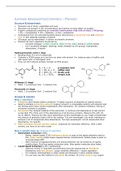Resume
Summary Advanced Food Chemistry - Phenolics part
- Cours
- Établissement
Summary Advanced Food Chemistry - Phenolics part FCH-30806 at Wageningen University This summary contains the following: - Structure and biosynthesis of phenolics - Analysis and isolation of phenolics - Oxidation of phenolics - Effect of structure on reactivity of phenolics - Inhibition of ...
[Montrer plus]



